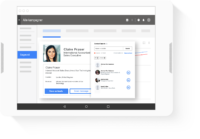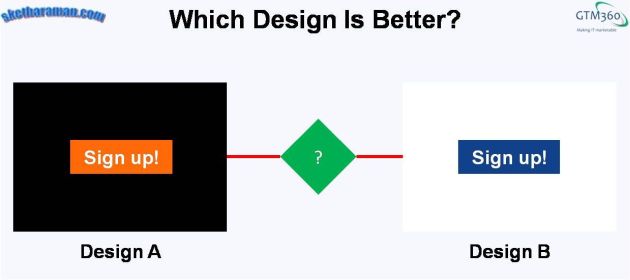Analytics is indispensable for a B2C website.
Website analytics tools like Google Analytics etc. reveal friction hotspots, blindzones, etc. and thereby help website owners redesign forms, modify CTAs, rotate online ads, etc.
(The use of multiple etceteras in the previous sentence is intentional – there are indeed many analytics tools available for doing many things on B2C websites to achieve many outcomes).
 Accordingly, B2C website analytics can drive significant uplift in conversion of browsers to buyers.
Accordingly, B2C website analytics can drive significant uplift in conversion of browsers to buyers.
In our success story entitled Retail Bank Sees Strong Uplift In Online Customer Acquisition, we’ve described how we used analytics to help the said retail bank to achieve nearly 3X increase in conversion rate on its instant account opening portal.
Now, coming to B2B websites. They attract way lower traffic than their B2C counterparts. Analytics tools require a certain minimum size of sample to yield statistically significant results. This suggests that analytics will struggle to deliver meaningful recommendations for B2B websites. That’s also the popular opinion among data scientists and B2B marketers.
People not working in experimentation/CRO throw "just A/B test it" around like it's as simple as writing a headline, as if you could run statistically valid tests on any page, any site.
The sad truth is that most SMBs dont have the volumes to run even a single test per month.
— Pe:p Laja (@peeplaja) April 28, 2020
Yes and no.
Yes, B2C websites attract a lot of traffic. It’s possible to run analytics that yield statistically significant recommendations in real time, which helps rotate online ads, etc. in real time. This is not possible in B2B websites because of their low traffic volume.
That said, B2B sales cycles last longer than B2C “look to book” funnels, so you don’t need to take B2B website actions in real time.
Let’s take a B2B website landing page. Nobody designs it every day. So, even if it takes a week for the website to attract enough traffic, it’s not a big deal. Sky will not fall if we need to run analytics for even a month to get statistically significant results.
And the good news is, most B2B websites we’ve studied do generate enough traffic to yield statistically significant insights in 2-4 weeks. Which is not too long when compared with the typical B2B sales cycle lasting months.
Let me give you an example.
We proposed two designs for the landing page of this SAAS provider.
Back in the day, our customer would have selected one out of these two alternative designs on the basis of HiPPO (Highest Paid Person’s Opinion).
But we guided them to use A/B testing to measure the conversion rate of visitors to leads on the two variants and decide on the best performing alternative based on that data.
It took two weeks for the tests to generate statistically significant results. But it was well worth the wait: Our recommendations yielded a 3X boost in conversion of the landing page.
More in the two part post entitled Art Meets Science With A/B Testing – Part 1 and Art Meets Science With A/B Testing – Part 2.
The above analytics relates to aggregate traffic.
Then there’s another relatively new genre of website analytics that’s based on individual traffic.
According to research and anecdotal evidence, 97% of visitors to B2B websites just come and go without making an inquiry or filling a form or taking any form of action. As a result, a bulk of your marketing spend is wasted.
Analytics based on individual traffic solves for this problem. Tools in this product category work on each individual visitor on a B2B website to inform their company name, email address, and direct / switchboard telephone number.

Using that data, B2B companies can prioritize the sequencing of their cold calls, thus achieving early wins; as also fine tune their Email Marketing, Social Media Marketing (SMM), and Search Engine Marketing (SEM) campaigns in order to boost the effectiveness of their overall outreach efforts.
These tools are useful whether a website gets 100 visitors a day or one visitor a day.
Ergo, we strongly recommend them for all B2B websites. (In fact, they’re not useful for B2C websites).
Caveat: Implementing these tools might call for amending website privacy policy and / or compliance with local data protection regulation, if any e.g. GDPR in EU, CCPA in California.
Back in the day, you’d have been right to worry about what your prospects and customers would think if your website was tracking their visits. But things have changed in the modern era of digitally-influenced procurement.
According to Forrester, the Buyer 2.0 wants your sales reps to anticipate his or her needs and serve them accordingly. The most transparent and scaleable way of fulfilling their expectation is via B2B analytics tools of the type discussed in this post.
Ergo, you should be worried if you’re not doing any visitor tracking in today’s world.
Don't worry what your customers will feel if you implement analytics on your B2B website – they actually expect you to. https://t.co/Tt7523rI9y https://t.co/tLcF0Fabkm
— GTM360 (@GTM360) July 16, 2020
That said, if you believe your target audience is ultra conservative, you may want to implement the guidance given in It’s time to ditch Google Analytics. Many analytics products described in this FASTCOMPANY article allow individual visitors to invoke the DO NOT TRACK option should they wish to be excluded from being tracked.
Having covered B2B website analytics based on aggregate traffic and individual traffic, I’ve completed the basic purpose of this blog post.
Before closing, let me take the opportunity to quickly touch upon the related space of B2B analytics outside the website.
According to McKinsey essay entitled The five lessons B2B sales leaders should learn to make analytics work,
Analytics isn’t likely to identify a whole new way to do business; rather, it will provide insights and opportunities to sell more and do so more efficiently. For more than two years, we have helped a number of B2B companies harness analytics to create significant value. We have seen the speed of the initiation of first sales increase by 50 percent, churn reduced by 25 percent, sales from new accounts rise 10 percent, and a 2 to 5 percent return on sales through pricing.

A plethora of B2B analytics products are available in the areas of lead scoring, email response tracking, win / loss, pricing, and so on.
Taking pricing as an illustration, let me describe a predictive analytics model we developed for a leading distributor of server, storage and networking infrastructure in the Middle East.
The distributor used the model to forecast future costs of CPU, RAM, hard disk and other components in the Bill of Material of a server. By using these inputs, its sales team was able to quote attractive prices, which improved its win-rate of government contracts and boosted its margins in a market segment that’s notorious for being driven solely by price aka L1. More at 3 Ways To Execute Government Technology Contracts Profitably.
While its utility is less obvious in B2B than B2C, analytics plays an equally important role in both types of industries. And, as we saw above, some types of analytics are more valuable in B2B than B2C websites.
